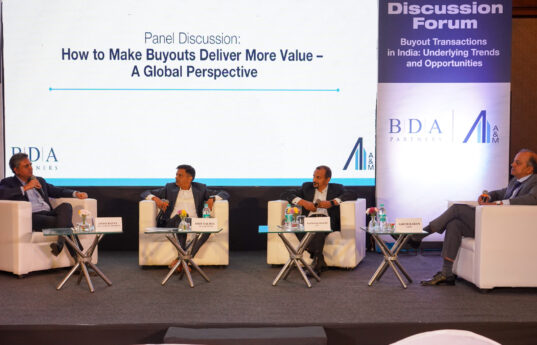2009/03/06
The Deal Magazine《交易杂志》引用了BDA高级董事经理Euan Rellie的话
The midmarket kingdom
By Thomas Zadvydas By now, everyone knows the China story: After Communist authorities loosened their grip a generation ago, trade and commerce flourished, attracting foreign direct investment. Private equity firms began to flock to China several years ago, finding sources of cheap materials for portfolio companies. The demands of a burgeoning middle class and further deregulation created growth opportunities Western firms could only dream of.
Why, then, is dealflow down?
Last year, the number of PE investments in China fell to 155, from 177 in 2007, according to a February report by Beijing research firm Zero2IPO Co. Ltd. Total deal value last year was around $9.61 billion, down from $12.8 billion in 2007. Deals are also getting smaller. In 2006, when 129 deals were announced, the total deal value clocked in at a total $12.97 billion, for an average size of about $100 million. In ’07 the average deal size was about $72 million. Last year: $62 million.
Zero2IPO views the slide “as a sign of adjustment and decline” from the global financial crisis. Dealmakers focused on the region increasingly sing the same tune heard in the West. “It became really tough in 2008 to bridge the disparate pricing expectations between buyers and sellers,” says Euan Rellie, senior managing director of Business Development Asia LLC, a New York advisory firm that specializes in the Asian market. “Valuations shrank as 2008 went on. The Shanghai Stock Exchange SSE index peaked above 6,000 in late 2007 but dropped to below 2,000 by late 2008. This reduced valuations but also made it harder to close deals.”
But beneath the surface other factors emerge. PE firms are increasingly pursuing minority stakes rather than assuming the regulatory burdens of taking over a Chinese company. Beijing still limits foreign control of sectors it deems vital to national interests.
The experience of the Carlyle Group has likely turned off PE firms from targeting these sectors, at least for now. Carlyle offered to buy a 40.32% stake in Chinese machinery maker Xugong Group Construction Machinery Co. Ltd. from the city of Xuzhou for $178.4 million. The deal languished in regulatory limbo for almost three years before both sides called it quits. The transaction would have been the first buyout of a state-owned enterprise by a foreign investor but was met with fierce backlash from Chinese politicians and media and was stalled by restrictions.
“Anything involving military, technology or other industries perceived as having a national security angle, all of these are difficult because politicians on both sides of the Pacific can throw up obstacles,” Rellie says. Other politically sensitive industries: oil, natural resources and telecom.
Accessibility to debt financing, or lack thereof, is another factor contributing to smaller deal sizes. “Not much leverage is used, and most [deals] tend to be all equity financed,” says Brett Tucker, partner at Baird Capital Partners Asia. Rellie says most firms route the money through Hong Kong whenever possible, as local rules make debt very difficult to find and structure. “Mezzanine financing [can be done] if you structure the transaction through Hong Kong, but it is really expensive.”
As a result, “there have been very few PE investments in China to date bigger than $150 million in enterprise value,” says BDA’s Rellie. “BDA has worked on transactions from $5 million to $300 million in value, which I would suppose equates to the small and middle market in the West. We would consider a $60 million transaction to be a decent midmarket transaction in China, which would be a small add-on by U.S. standards,” he says.
Others offer a similar range. “We think the middle market for China private equity is companies with revenue between $25 and $100 million,” says Tucker, whose firm is targeting companies between $15 million and $50 million in size.
Another explanation for smaller deals in recent years is that early PE dealmaking in China was skewed because of the larger size of targets. China entered the World Trade Organization in 2001. The WTO forced China to sell off assets, and newly privatized enterprises desperately needed capital, while the Chinese banking system turned out to be horribly inefficient. Enter private equity. “It was in this post-WTO transitional period that the world’s major private equity firms decided to enter China in a significant way,” says a report by Erik Bethel, managing director of ChinaVest Ltd., a Shanghai-based merchant bank that helps clients enter the China market.
Despite the pullback, nobody appears ready to give up on China. In fact, many believe the region is poised for a massive PE boom.
“Private equity firms will make a number of small investments, watch them closely and continue investing in those that do well,” says Rellie, who predicts firms will get more small deals done in the second half. “Distressed and restructuring situations will throw up amazing bargains for PE firms who have cash on their books.”
Sectors such as real estate, education, energy and retail look poised for midmarket-size investment. “Everything right now [is ripe]. Logistics, real estate, food and agriculture, pharma, healthcare,” says Richard Brubaker, managing director of Shanghai advisory firm China Strategic Development Partners. “With the Shanghai market off 60% and IPOs at a minimum, the opportunities are coming back into the market. The ability of PE firms to find deals is higher.”
“Other areas that have been popular are clean technology [wind, solar] and water treatment,” Baird’s Tucker adds. Industries that capitalize on infrastructure, as well as on healthcare and retail, are ripe.
“We prefer to work on traditional, easily understood industrial areas, around advanced manufacturing, chemicals and automotive, as well as some consumer products such as packaged foods,” BDA’s Rellie says.
One firm new to China is Century Bridge Capital, a real estate-focused private equity firm with operations in Dallas and Beijing. Century closed its first deal on Jan. 6, a $41.4 million middle-income real estate investment project in Xian, China. The firm is forming a joint venture with Beijing real estate development company Jia Heng Real Estate.
Century Bridge pumped $19 million into the project, with the remaining equity coming from Jia Heng.
“We’re focusing on middle-income housing, and the reason … is there is what I call a long-term macro opportunity,” says Century Bridge chief executive Tom Delatour.
Along with China’s stock decline, PE funds are drawn by the growth and continued optimism of its middle class. “Investments in companies that target China’s emerging 250-million-strong middle class will continue to pay dividends, as the group remains optimistic,” wrote Shaun Rein, founder and managing director of China Market Research Group, a market intelligence firm based in Shanghai, in BusinessWeek.
“There is a very large pent-up demand for middle-income housing, there’s a very large growing middle class in China and, depending on whose research you read, there is probably 10 years of pent-up demand for that product type,” adds Delatour.
With China’s increasing population, London private equity firm Actis Capital LLP is betting on its need to be educated. The firm led a $103 million investment in Ambow Education Co. Ltd., a student assessment and training provider, in October 2008. That month, Actis teamed with New York’s Warburg Pincus in a $65 million investment in Chinese budget hotel operator 7 Days Group Holdings Ltd.
“China will post 30%-plus annual growth in private equity investing for the next three years,” Rein wrote. In particular, November 2008 data from Zero2IPO indicates consumer demand will continue to rise, as urban per capita disposable income has averaged a healthy 10% growth rate over the past three years.
All signs point to a rebound in PE deals in China.
Provided, of course, funds stay out of “politically sensitive” sectors.
And the world doesn’t collapse
http://www.thedeal.com/newsweekly/features/the-midmarket-kingdom.php




